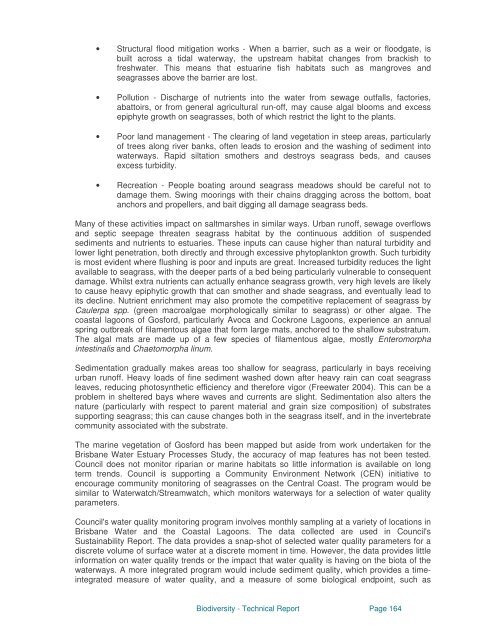Biodiversity Strategy - Gosford City Council - NSW Government
Biodiversity Strategy - Gosford City Council - NSW Government
Biodiversity Strategy - Gosford City Council - NSW Government
You also want an ePaper? Increase the reach of your titles
YUMPU automatically turns print PDFs into web optimized ePapers that Google loves.
• Structural flood mitigation works - When a barrier, such as a weir or floodgate, is<br />
built across a tidal waterway, the upstream habitat changes from brackish to<br />
freshwater. This means that estuarine fish habitats such as mangroves and<br />
seagrasses above the barrier are lost.<br />
• Pollution - Discharge of nutrients into the water from sewage outfalls, factories,<br />
abattoirs, or from general agricultural run-off, may cause algal blooms and excess<br />
epiphyte growth on seagrasses, both of which restrict the light to the plants.<br />
• Poor land management - The clearing of land vegetation in steep areas, particularly<br />
of trees along river banks, often leads to erosion and the washing of sediment into<br />
waterways. Rapid siltation smothers and destroys seagrass beds, and causes<br />
excess turbidity.<br />
• Recreation - People boating around seagrass meadows should be careful not to<br />
damage them. Swing moorings with their chains dragging across the bottom, boat<br />
anchors and propellers, and bait digging all damage seagrass beds.<br />
Many of these activities impact on saltmarshes in similar ways. Urban runoff, sewage overflows<br />
and septic seepage threaten seagrass habitat by the continuous addition of suspended<br />
sediments and nutrients to estuaries. These inputs can cause higher than natural turbidity and<br />
lower light penetration, both directly and through excessive phytoplankton growth. Such turbidity<br />
is most evident where flushing is poor and inputs are great. Increased turbidity reduces the light<br />
available to seagrass, with the deeper parts of a bed being particularly vulnerable to consequent<br />
damage. Whilst extra nutrients can actually enhance seagrass growth, very high levels are likely<br />
to cause heavy epiphytic growth that can smother and shade seagrass, and eventually lead to<br />
its decline. Nutrient enrichment may also promote the competitive replacement of seagrass by<br />
Caulerpa spp. (green macroalgae morphologically similar to seagrass) or other algae. The<br />
coastal lagoons of <strong>Gosford</strong>, particularly Avoca and Cockrone Lagoons, experience an annual<br />
spring outbreak of filamentous algae that form large mats, anchored to the shallow substratum.<br />
The algal mats are made up of a few species of filamentous algae, mostly Enteromorpha<br />
intestinalis and Chaetomorpha linum.<br />
Sedimentation gradually makes areas too shallow for seagrass, particularly in bays receiving<br />
urban runoff. Heavy loads of fine sediment washed down after heavy rain can coat seagrass<br />
leaves, reducing photosynthetic efficiency and therefore vigor (Freewater 2004). This can be a<br />
problem in sheltered bays where waves and currents are slight. Sedimentation also alters the<br />
nature (particularly with respect to parent material and grain size composition) of substrates<br />
supporting seagrass; this can cause changes both in the seagrass itself, and in the invertebrate<br />
community associated with the substrate.<br />
The marine vegetation of <strong>Gosford</strong> has been mapped but aside from work undertaken for the<br />
Brisbane Water Estuary Processes Study, the accuracy of map features has not been tested.<br />
<strong>Council</strong> does not monitor riparian or marine habitats so little information is available on long<br />
term trends. <strong>Council</strong> is supporting a Community Environment Network (CEN) initiative to<br />
encourage community monitoring of seagrasses on the Central Coast. The program would be<br />
similar to Waterwatch/Streamwatch, which monitors waterways for a selection of water quality<br />
parameters.<br />
<strong>Council</strong>'s water quality monitoring program involves monthly sampling at a variety of locations in<br />
Brisbane Water and the Coastal Lagoons. The data collected are used in <strong>Council</strong>'s<br />
Sustainability Report. The data provides a snap-shot of selected water quality parameters for a<br />
discrete volume of surface water at a discrete moment in time. However, the data provides little<br />
information on water quality trends or the impact that water quality is having on the biota of the<br />
waterways. A more integrated program would include sediment quality, which provides a timeintegrated<br />
measure of water quality, and a measure of some biological endpoint, such as<br />
<strong>Biodiversity</strong> - Technical Report Page 164
















